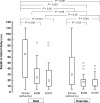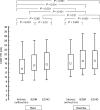Cardiac resynchronization therapy during rest and exercise: comparison of two optimization methods
- PMID: 18753213
- PMCID: PMC2552406
- DOI: 10.1093/europace/eun216
Cardiac resynchronization therapy during rest and exercise: comparison of two optimization methods
Abstract
Aims: Optimal exercise programming of cardiac resynchronization therapy (CRT) devices is unknown. We aimed to: (i) investigate variations in optimal atrioventricular (AV) and interventricular (VV) delays from rest to exercise, assessed by both echocardiography and an automated intracardiac electrogram (IEGM) method; (ii) evaluate the acute haemodynamic impact of CRT optimization performed during exercise.
Methods and results: Twenty-four heart failure patients, previously implanted with a CRT defibrillator, underwent AV and VV delay optimization, by echocardiography and IEGM methods, both at rest and during supine bicycle exercise. Rest-to-exercise variations in optimal VV delay were observed in 58% of patients. Conversely, optimal AV delay did not change during exercise compared with rest. Substantial agreement of AV and VV delays was observed between both the optimization methods. Exercise optimization of VV delay by either method improved intraventricular dyssynchrony and increased aortic velocity time integral compared with the resting setting (P < 0.001).
Conclusion: In patients implanted with a CRT device, optimal VV delay varied considerably from rest to exercise, while AV delay did not change. Re-assessment of the optimal pacing configuration during supine exercise, by echocardiography as well as IEGM methods, yielded an additional haemodynamic benefit to that provided by resting optimization.
Figures




Similar articles
-
Acute evaluation of programmer-guided AV/PV and VV delay optimization comparing an IEGM method and echocardiogram for cardiac resynchronization therapy in heart failure patients and dual-chamber ICD implants.J Cardiovasc Electrophysiol. 2007 Feb;18(2):185-91. doi: 10.1111/j.1540-8167.2006.00671.x. J Cardiovasc Electrophysiol. 2007. PMID: 17338767
-
Manual Intracardiac Electrogram Method Is Accurate Alternative to Echocardiography for Atrioventricular and Interventricular Optimization in Cardiac Resynchronization Therapy.Acta Clin Croat. 2017 Dec;56(4):618-624. doi: 10.20471/acc.2017.56.04.06. Acta Clin Croat. 2017. PMID: 29590714
-
Reliability of a novel intracardiac electrogram method for AV And VV delay optimization and comparability to echocardiography procedure for determining optimal conduction delays in CRT patients.Indian Pacing Electrophysiol J. 2009;9(2):91-101. Epub 2009 Mar 15. Indian Pacing Electrophysiol J. 2009. PMID: 19308277 Free PMC article.
-
Echocardiographic optimization of the atrioventricular and interventricular intervals during cardiac resynchronization.Europace. 2008 Nov;10 Suppl 3:iii88-95. doi: 10.1093/europace/eun220. Europace. 2008. PMID: 18955406 Review.
-
Comparison between IEGM-based approach and echocardiography in AV/PV and VV delay optimization in CRT-D recipients (Quicksept study).Indian Pacing Electrophysiol J. 2016 Mar-Apr;16(2):59-65. doi: 10.1016/j.ipej.2016.05.001. Epub 2016 Jun 3. Indian Pacing Electrophysiol J. 2016. PMID: 27676162 Free PMC article. Review.
Cited by
-
Exercise test is essential in LV-only fusion CRT pacing without right ventricle lead.Clin Interv Aging. 2019 Jun 4;14:969-975. doi: 10.2147/CIA.S206251. eCollection 2019. Clin Interv Aging. 2019. PMID: 31239651 Free PMC article.
-
Impact of moderate exercise workload on predicted optimal AV and VV delays determined by an intracardiac electrogram-based method for optimizing cardiac resynchronization therapy.Clin Res Cardiol. 2010 Nov;99(11):735-41. doi: 10.1007/s00392-010-0178-y. Epub 2010 Jun 2. Clin Res Cardiol. 2010. PMID: 20517697 Clinical Trial.
-
Atrioventricular and interventricular delay optimization in cardiac resynchronization therapy: physiological principles and overview of available methods.Heart Fail Rev. 2011 May;16(3):263-76. doi: 10.1007/s10741-010-9215-1. Heart Fail Rev. 2011. PMID: 21431901 Free PMC article. Review.
-
Shortening of atrioventricular delay at increased atrial paced heart rates improves diastolic filling and functional class in patients with biventricular pacing.Cardiovasc Ultrasound. 2012 Jan 24;10:2. doi: 10.1186/1476-7120-10-2. Cardiovasc Ultrasound. 2012. PMID: 22269022 Free PMC article.
-
SmartDelay determined AV optimization: a comparison of AV delay methods used in cardiac resynchronization therapy (SMART-AV): rationale and design.Pacing Clin Electrophysiol. 2010 Jan;33(1):54-63. doi: 10.1111/j.1540-8159.2009.02581.x. Epub 2009 Oct 10. Pacing Clin Electrophysiol. 2010. PMID: 19821938 Free PMC article. Clinical Trial.
References
-
- Bax JJ, Abraham T, Barold SS, Breithardt OA, Fung JW, Garrigue S, et al. Cardiac resynchronization therapy. Part 2: issues during and after device implantation and unresolved questions. J Am Coll Cardiol. 2005;46:2168–82. - PubMed
-
- Cleland JG, Daubert JC, Erdmann E, Freemantle N, Gras D, Kappenberger L, et al. The effect of cardiac resynchronization on morbidity and mortality in heart failure. N Engl J Med. 2005;352:1539–49. - PubMed
-
- Bordachar P, Lafitte S, Reuter S, Serri K, Garrigue S, Laborderie J, et al. Echocardiographic assessment during exercise of heart failure patients with cardiac resynchronization therapy. Am J Cardiol. 2006;97:1622–5. - PubMed
-
- Valzania C, Gadler F, Eriksson MJ, Olsson A, Boriani G, Braunschweig F. Electromechanical effects of cardiac resynchronization therapy during rest and stress in patients with heart failure. Eur J Heart Fail. 2007;9:644–50. - PubMed
-
- Leclercq C, Ansalone G, Gadler F, Boriani G, Perez-Castellano N, Grubb N, et al. Biventricular vs. left ventricular pacing in heart failure: rationale, design and endpoints of the B-LEFT HF study. Europace. 2006;8:76–80. - PubMed
Publication types
MeSH terms
LinkOut - more resources
Full Text Sources
Medical
Research Materials

